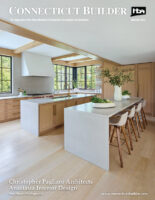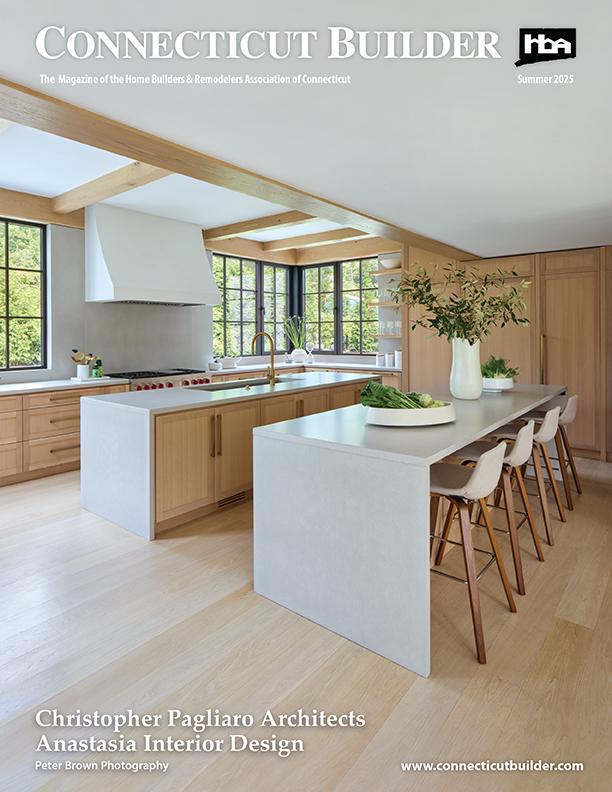
The Heart & Soul of Today’s Homes
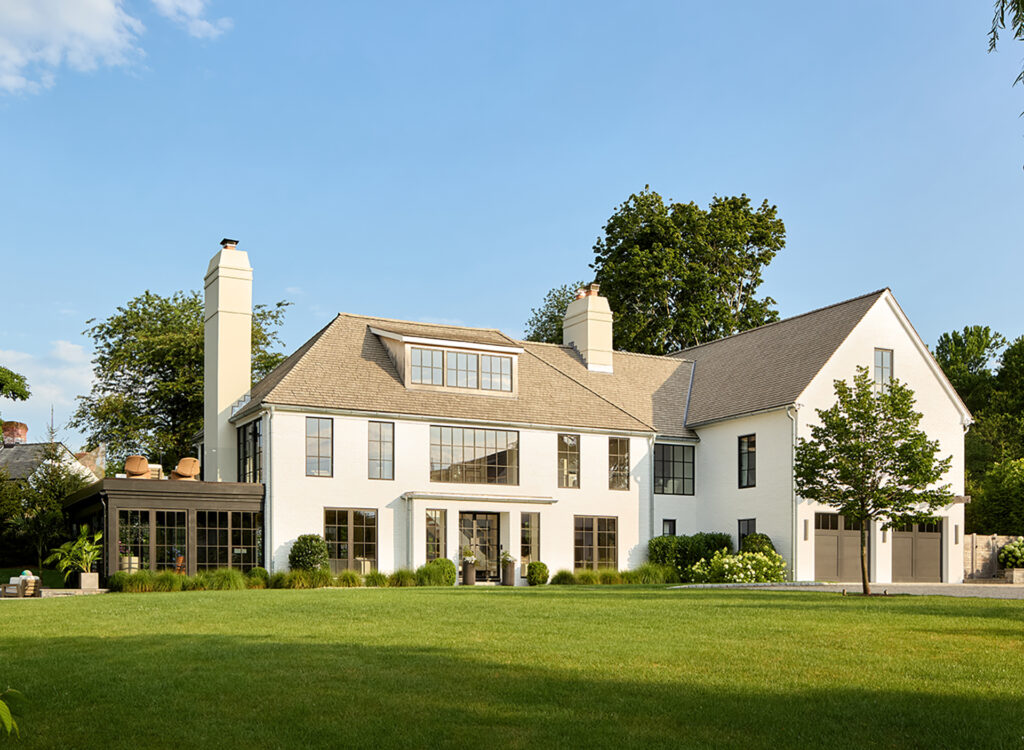
Architect Chris Pagliaro’s 5th Connecticut Builder cover is the kitchen of his recent transformation of a tired 1950’s colonial in Southport.
Project Builder: Nick Frate of Fox Hill Builders.
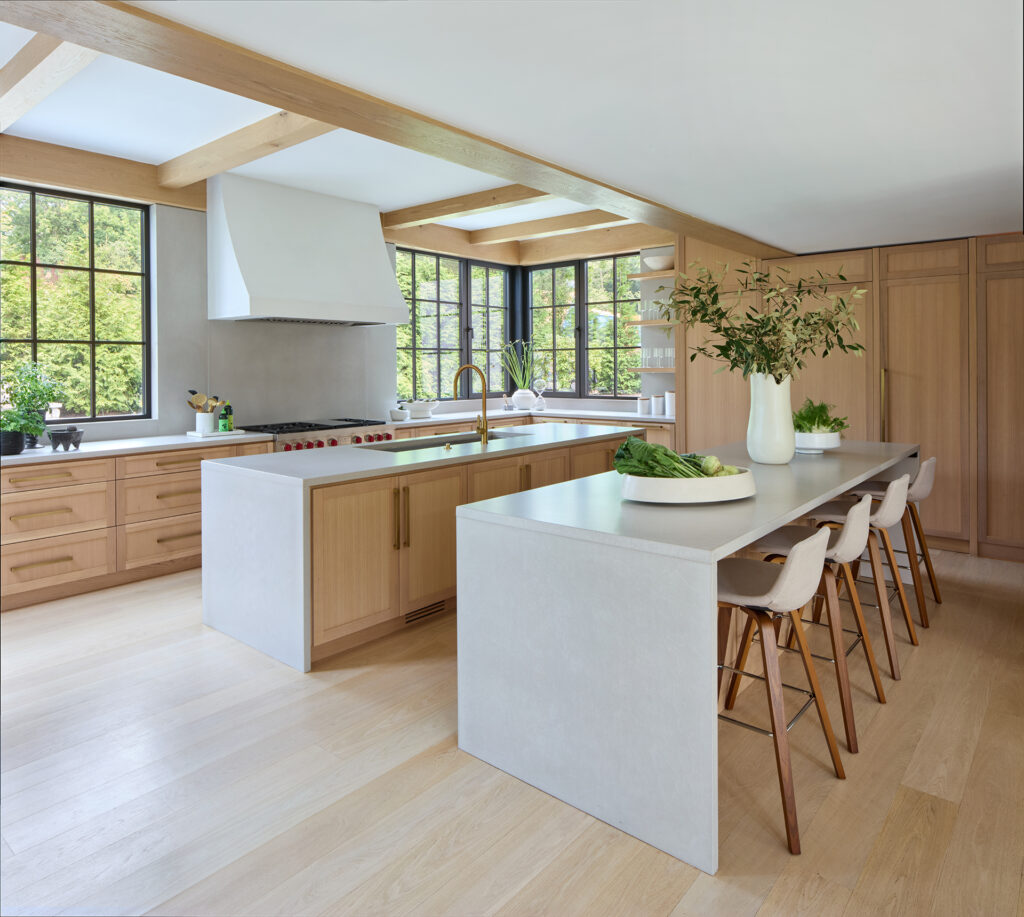
“White oak in a natural finish, and the concrete countertops and backsplash provide natural elements in the space. Striking black framed windows, bring the outside in and add depth.”
– Tina Anastasia
The interior designer of our cover kitchen, Tina Anastasia, describes this kitchen’s special features, including great circulation, with “dueling islands – one for prep and one for sitting.”
The kitchen is where families gather, meals are prepared, and memories are made. The bathroom is a more intimate and private space, used for relaxation and self-care. It’s a place of retreat and tranquility.
In essence, the kitchen is the home’s heart – while the primary bathroom is its soul refresher – a space for quiet reflection and tranquility.

Southport bath by Tina Anastasia
For a house he designed on the Connecticut coast, he found a like-minded cohort in Tina Anastasia of Anastasia Interior Design, whose analogy is more literary than musical. For her, design is a narrative revealed in well-constructed chapters that are bound together like a book. “Each element is just one piece that ultimately has to be about the whole story,” she says.

Beyond it’s natural, calming aesthetic, concrete’s chief benefit is its versatility. Concrete is an ideal choice for those seeking very specific parameters – such as a particular color, finish, thickness, shape, feature, or set of dimensions.
In this project, it’s clear that Tina approached concrete as more a raw building material than a fixed object – because in designing this one home, she employed concrete in several distinct settings. Trueform fabricated and installed kitchen countertops, matching backsplashes, and two fireplace surrounds.
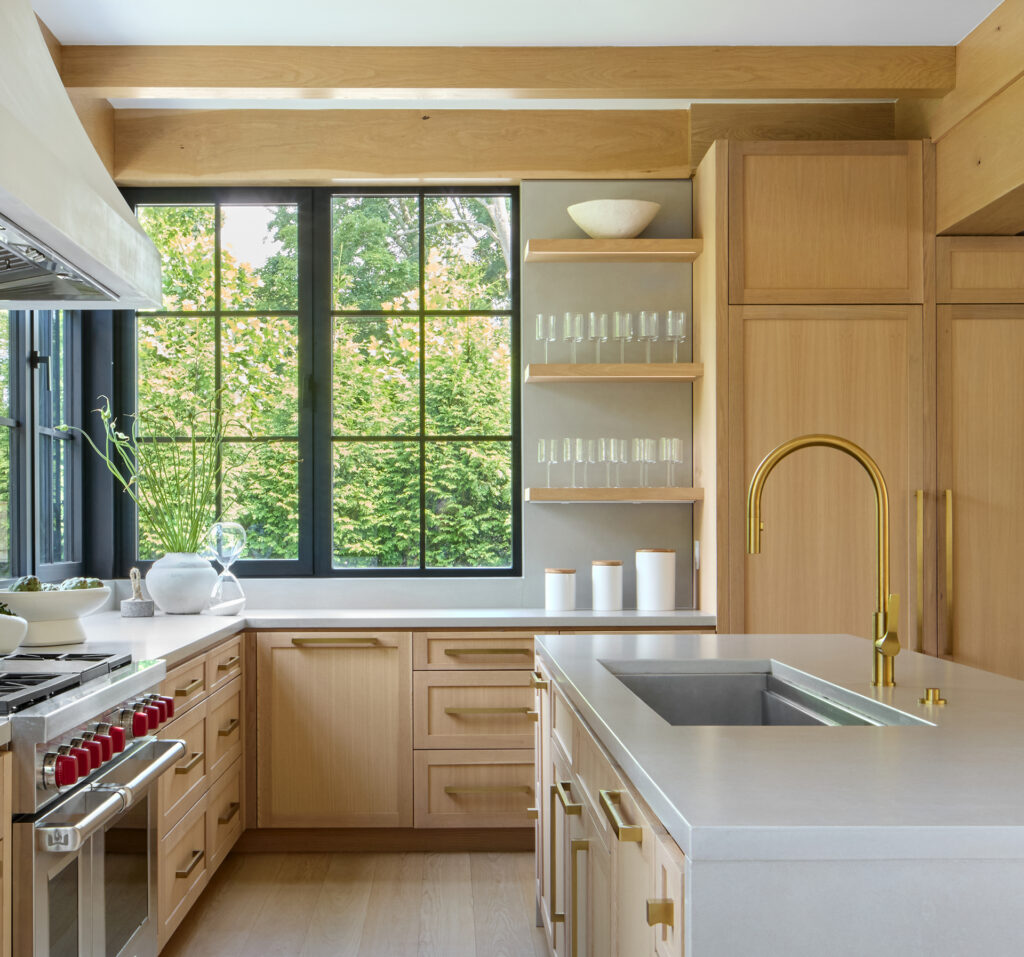
Concrete – less time to install and minimal seams
Paul described the thinking behind Tina’s choice and what the installation process involved. “Tina understood that concrete would deliver an unparalleled level of harmony between the vertical and horizontal surfaces for a truly integrated look. Our team visited the home and created templates of the entire kitchen space to ensure that all the individual pieces we fabricated in our NJ facility fit perfectly upon our return. An added benefit of the concrete backsplash is that the installation was completed in a single visit – far less time and energy than the traditional tile and grout method. it also means far less seams – and therefore far less chance of issues down the road.”
“One unique feature we appreciate about Tina’s design is the backsplash area directly below the hood, which projects an extra ½” from the rest of the surface,” Paul explained. “This subtle, proud detail shows the designer’s intent – giving the wall some structure while highlighting and framing the hood itself. Trueform was able to achieve this simply by casting this particular backsplash tile thicker than the rest.”
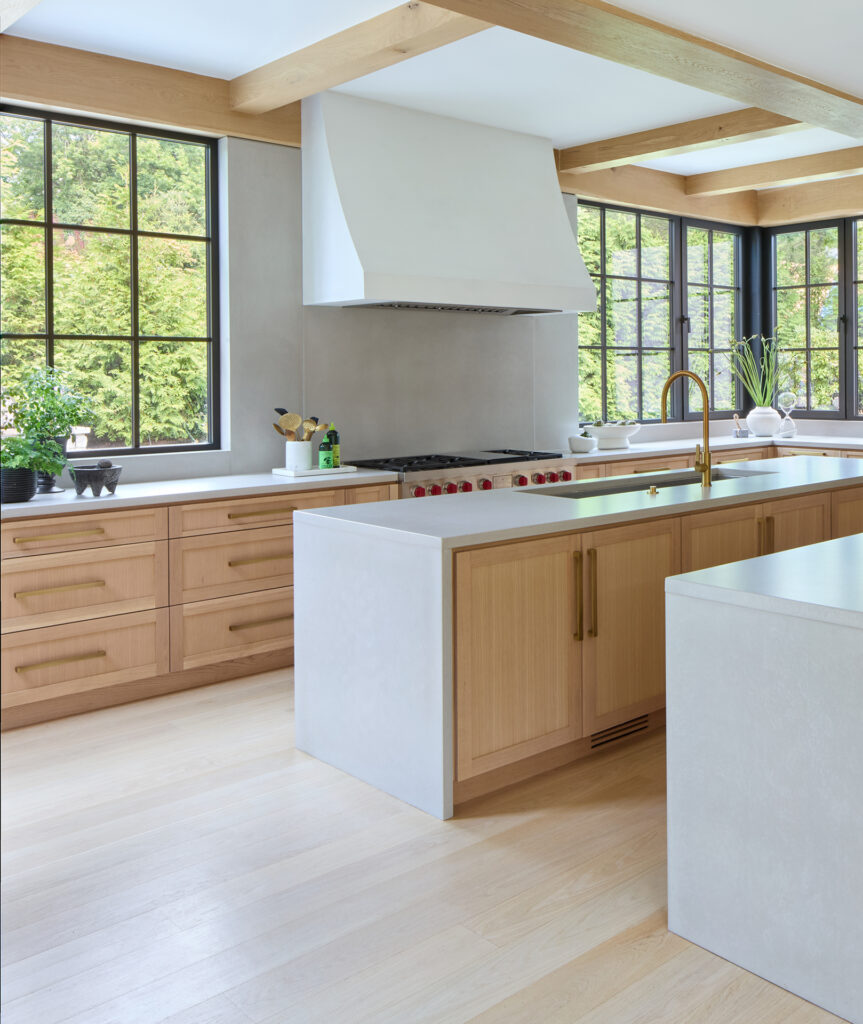
Trueform’s Paul Grech on trends
“One of the trends we’re seeing over at Trueform is the increasing tendency of designers and architects to integrate smart features – such as shallow shelves for storing spices or plants other small objects – directly into their concrete backsplash. Clever details like this really showcase a designer’s ability to think not only of the end user, but of the usefulness of the material itself.
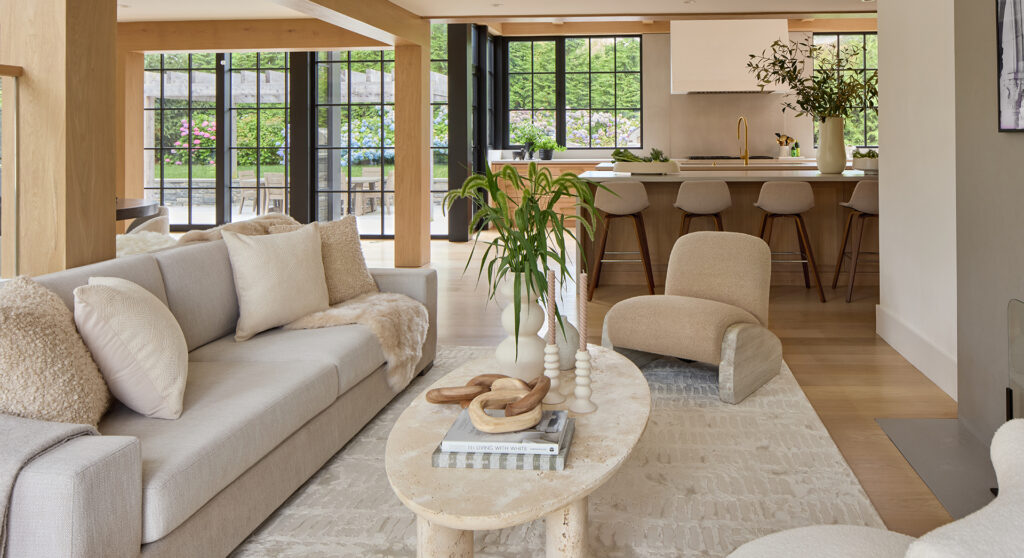
Another trend we’re witnessing – also captured in this project – is the employment of waterfall legs. Waterfall legs are vertical slabs that run from the edge of a countertop to the floor –essentially “wrapping” the island in a concrete skin. Doing this not only avoids having to detail or finish the side(s) of an island, but it also creates the illusion that the island is a cohesive, encapsulated object. It’s like an exclamation point on the overall design. “
– Paul Grech, Trueform Concrete
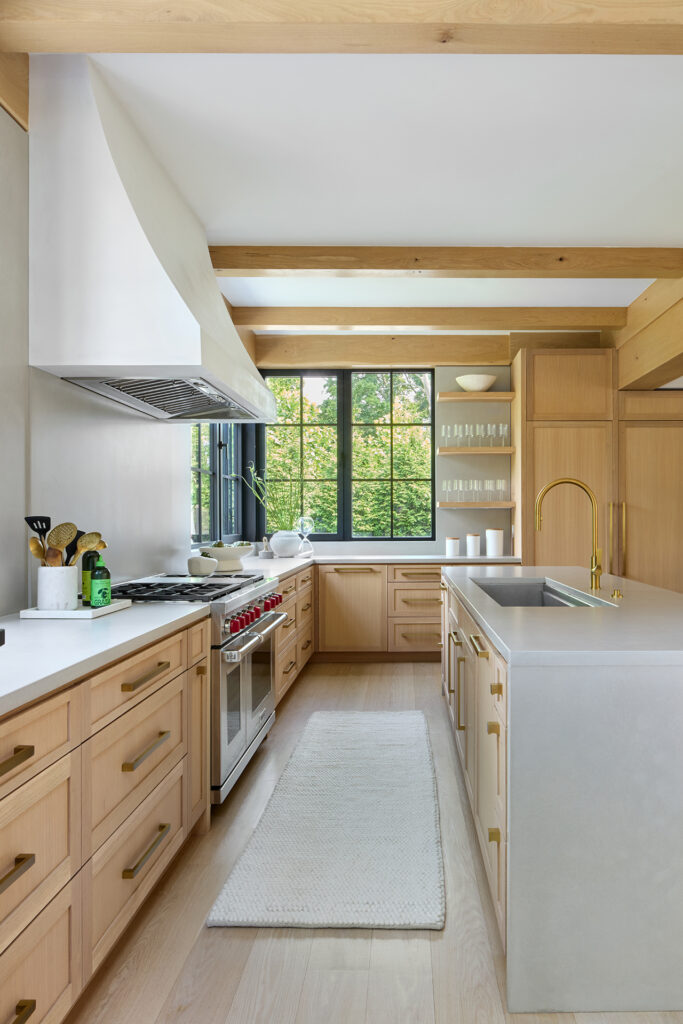
Iron Oaks brings hand crated cabinetry and a value engineered budget to the project
Tina worked with Iron Oaks as the cabinet maker for the kitchen. The Long Island City based company specializes in architectural millwork, handcrafted furniture and cabinetry.
“The homeowner brought us into the project,” explained Iron Oaks Project Manager, Erik Pfannenstiel. “He wanted this kitchen to be a place for him to entertain, and from any site line, this room feels inviting.”
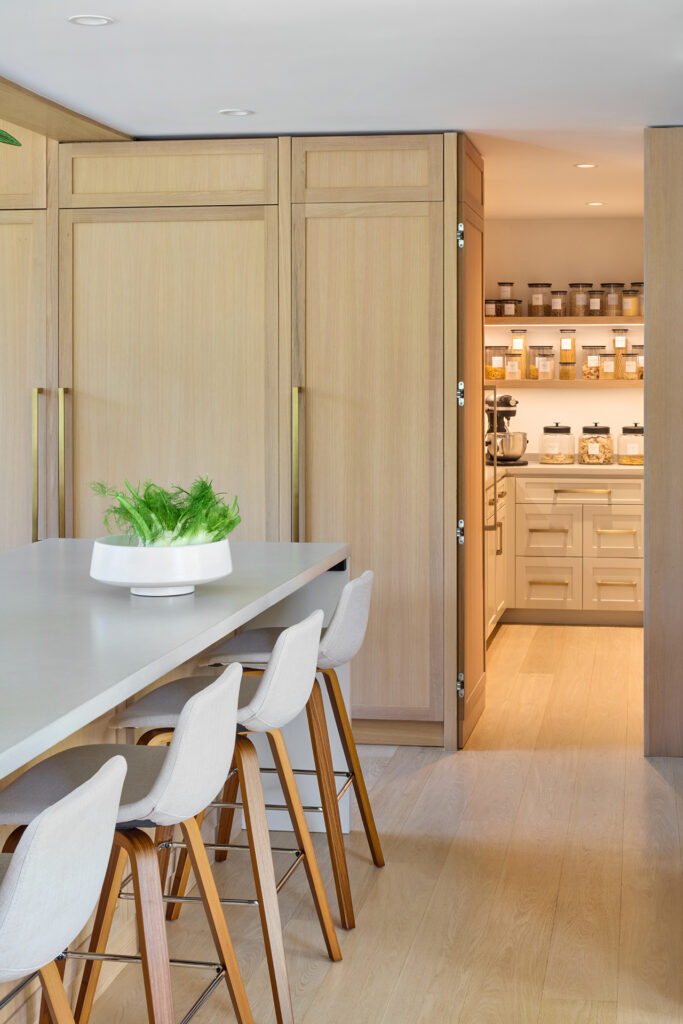
This project was a great example of everyone – Tina, Chris, Trueform, Iron Oaks and the client – all being on the same page. The client had a vision, and we all brought it to life.” – Erik Pfannenstiel, Design Director & PM, Iron Oaks
“The client felt that the concrete counters brought texture and played off each other and the plaster walls. For the cabinetry, we used white oak with slow close drawers, and hardware is so important.
Tina and Chris specified a ½” reveal between the countertops and the cabinets. Chris and Tina’s attention to detail is phenomenal. Chris insists that any transition of material has the right separation. Creating that intentionality helps integrate without being aligned.”
Integrated Thermador appliances from Aitoro blend seamlessly with cabinetry, and another great feature of this project is the hidden pantry, which creates a little mystery. This is a definite trend. In other projects, we’ve used sliding doors and pocket doors to hide a coffee station, and a hidden door to a basement Speakeasy called the “Rabbit Hole”. In this case, the door to the pantry looks like a cabinet.”
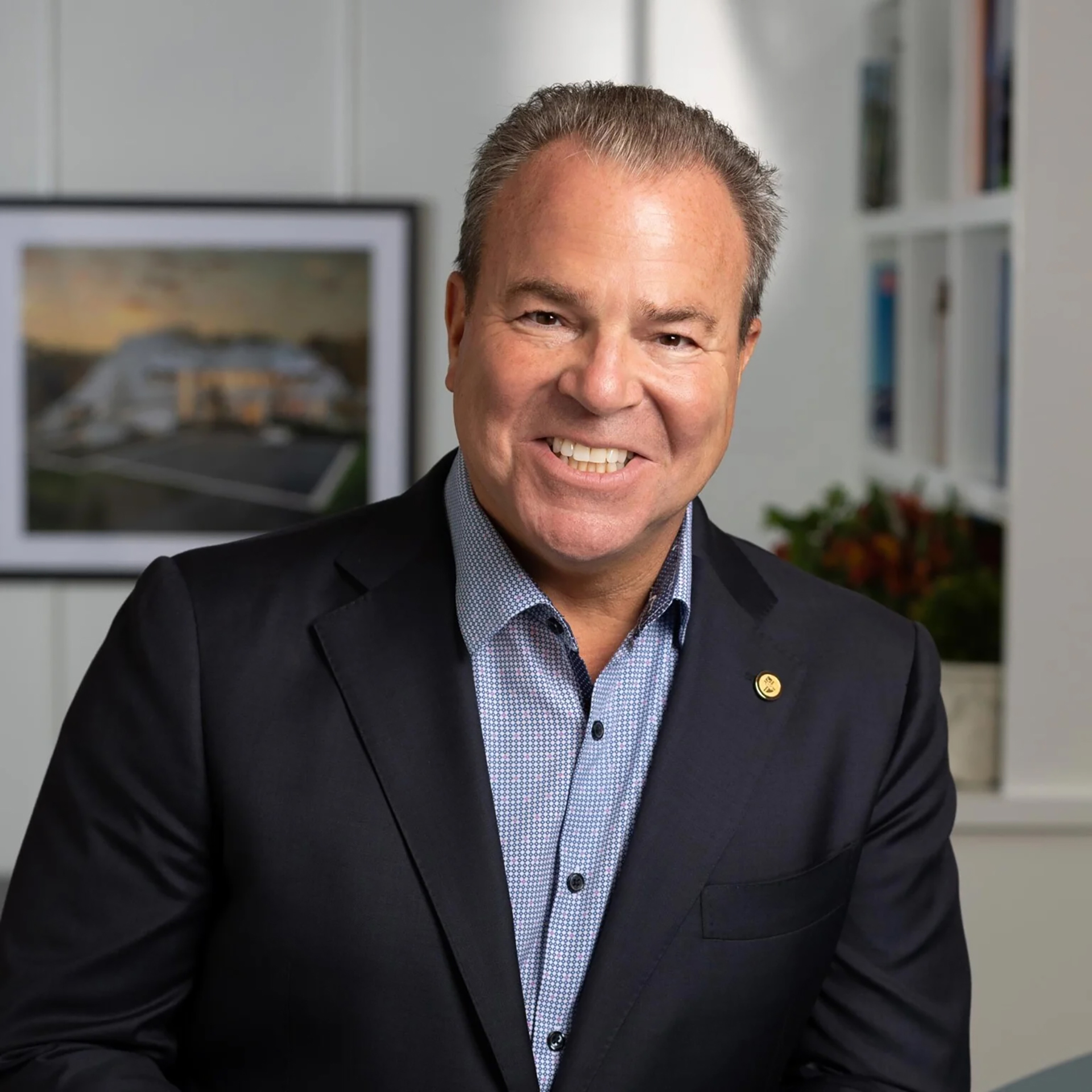
“I am always trying to find a way to be ahead of what’s next in residential architecture in New England. We have been very busy, and I think that architecture and interior design is finding its way back to more traditional materials. I don’t think that means traditional architecture, but rather a way of giving warmth and coziness to the open planning that people still desire – though many are finally coming back to wanting areas of comfort and enclosure within those plans. Masonry materials, new interpretations of traditional roofing, warmth in the natural materials of the exterior landscape, and detailing of the architecture that offers a hint of the more traditional. That doesn’t mean 9-piece moldings, or ridiculously heavy roof rakes, but rather some softness to the designs.” – Chris Pagliaro
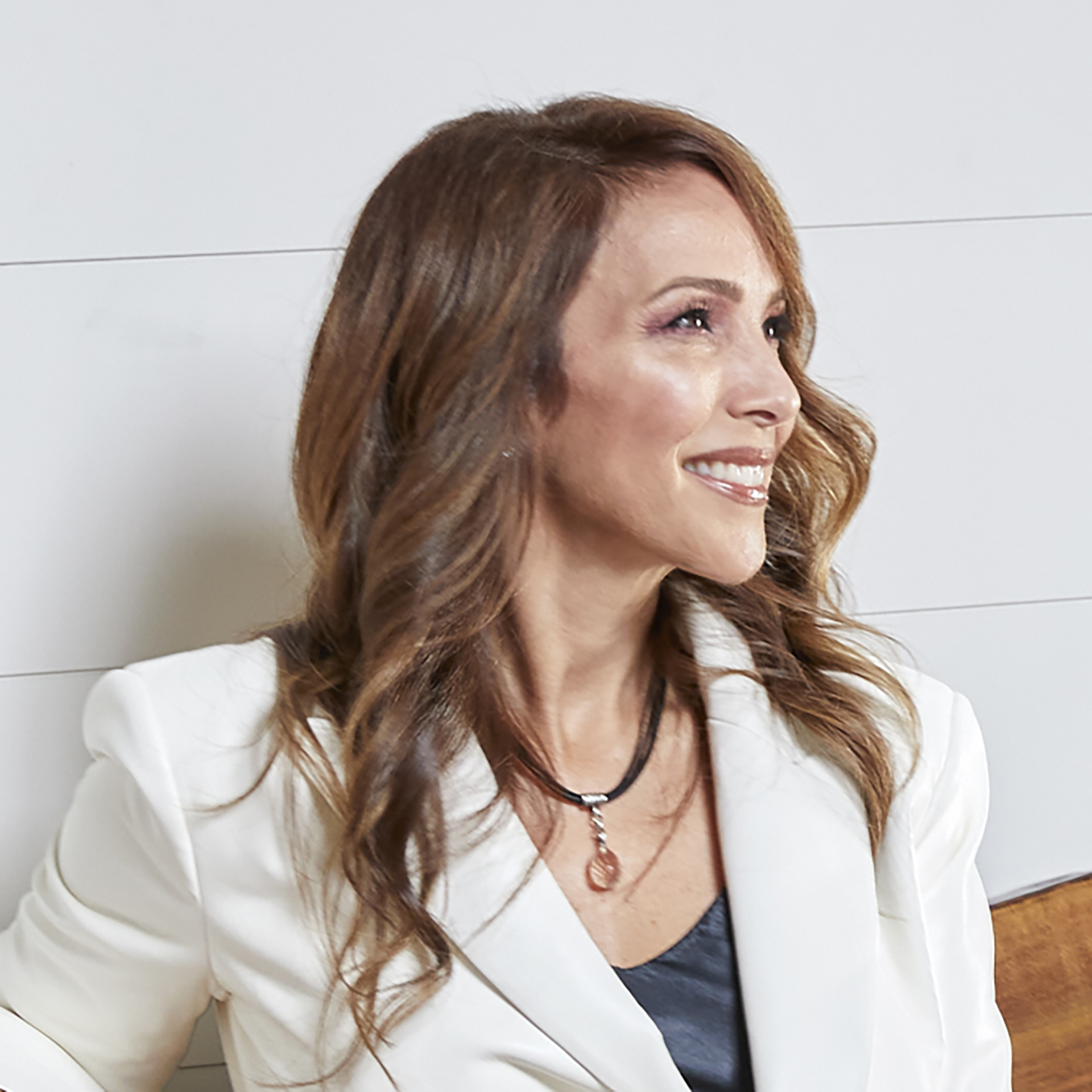
“In 2025, interior design is focused on creating spaces that nurture health and well-being, including sleep patterns and spaces for relaxation. Products like cold plunge baths and saunas are becoming additions to gym areas. Luxury is no longer about costs and excess, but more about expressing individuality through artisanal craftsmanship. Moving away from separation, spaces are being created to promote genuine connections and camaraderie.” – Tina Anastasia
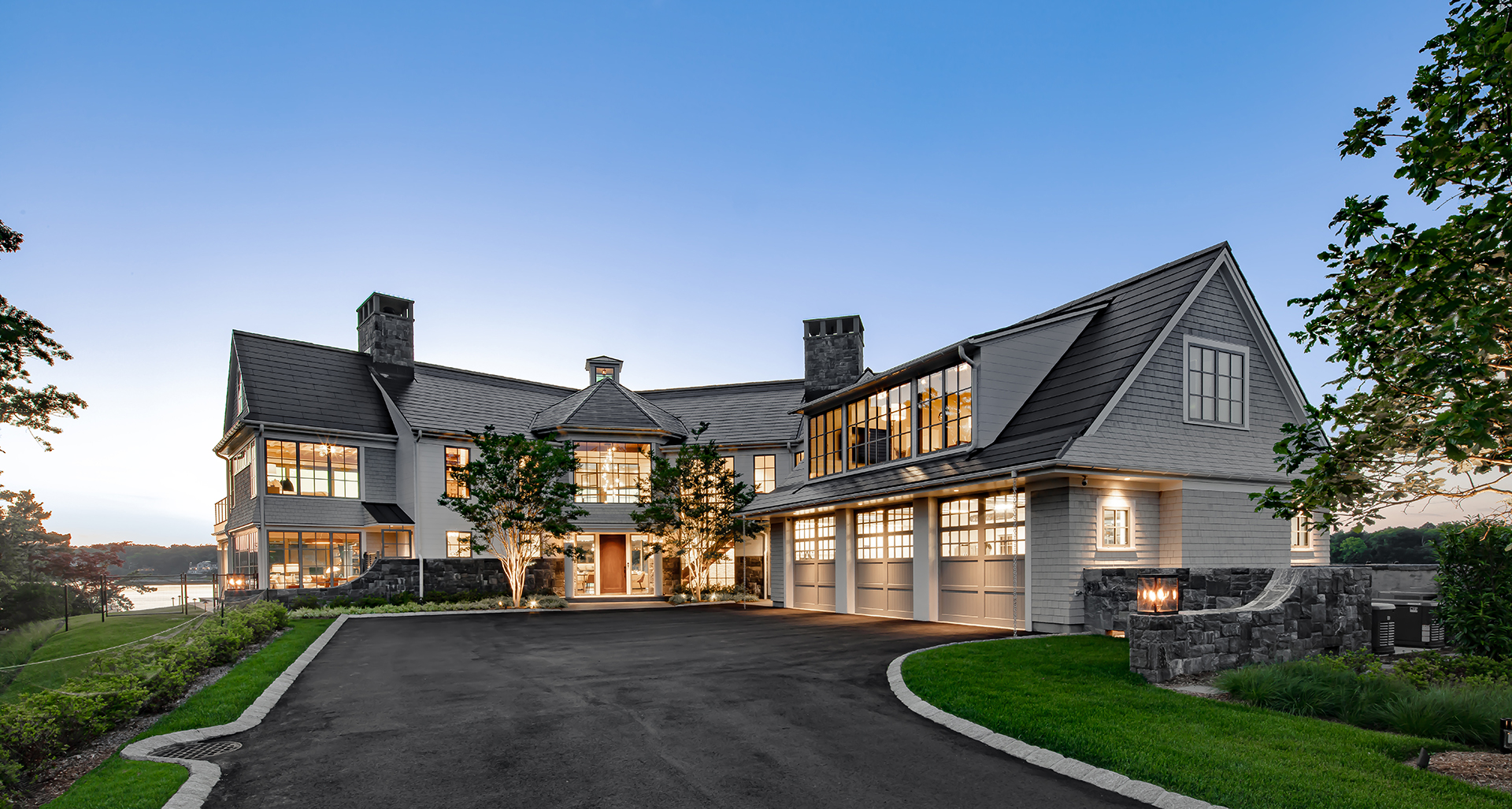


Coveledge, Contentment Island Darien
Chris Pagliaro teamed up with Tina Anastasia and Long Neck Builders on a HOBI winning custom home on Contentment Island in Darien. This kitchen features a golden white oak island with quartzite counters, a white oak beamed ceiling and walls of glass for panoramic view of Long Island Sound. The light fixtures, Tina refers to as “The Clams” are made by Shakuff.
The white oak cabinetry is by Frank Byrne, Byrne Woodworking, and the material on the island is Perla Venata quartzite and was fabricated through Point Rock Surfaces, along with the integrated stone sink.

Architect Chris Pagliaro’s 5th Connecticut Builder cover is the kitchen of his recent transformation of a tired 1950’s colonial in Southport.
Project Builder: Nick Frate of Fox Hill Builders.

“White oak in a natural finish, and the concrete countertops and backsplash provide natural elements in the space. Striking black framed windows, bring the outside in and add depth.”
– Tina Anastasia
The interior designer of our cover kitchen, Tina Anastasia, describes this kitchen’s special features, including great circulation, with “dueling islands – one for prep and one for sitting.”
The kitchen is where families gather, meals are prepared, and memories are made. The bathroom is a more intimate and private space, used for relaxation and self-care. It’s a place of retreat and tranquility.
In essence, the kitchen is the home’s heart – while the primary bathroom is its soul refresher – a space for quiet reflection and tranquility.

Southport bath by Tina Anastasia
For a house he designed on the Connecticut coast, he found a like-minded cohort in Tina Anastasia of Anastasia Interior Design, whose analogy is more literary than musical. For her, design is a narrative revealed in well-constructed chapters that are bound together like a book. “Each element is just one piece that ultimately has to be about the whole story,” she says.

Beyond it’s natural, calming aesthetic, concrete’s chief benefit is its versatility. Concrete is an ideal choice for those seeking very specific parameters – such as a particular color, finish, thickness, shape, feature, or set of dimensions.
In this project, it’s clear that Tina approached concrete as more a raw building material than a fixed object – because in designing this one home, she employed concrete in several distinct settings. Trueform fabricated and installed kitchen countertops, matching backsplashes, and two fireplace surrounds.

Concrete – less time to install and minimal seams
Paul described the thinking behind Tina’s choice and what the installation process involved. “Tina understood that concrete would deliver an unparalleled level of harmony between the vertical and horizontal surfaces for a truly integrated look. Our team visited the home and created templates of the entire kitchen space to ensure that all the individual pieces we fabricated in our NJ facility fit perfectly upon our return. An added benefit of the concrete backsplash is that the installation was completed in a single visit – far less time and energy than the traditional tile and grout method. it also means far less seams – and therefore far less chance of issues down the road.”
“One unique feature we appreciate about Tina’s design is the backsplash area directly below the hood, which projects an extra ½” from the rest of the surface,” Paul explained. “This subtle, proud detail shows the designer’s intent – giving the wall some structure while highlighting and framing the hood itself. Trueform was able to achieve this simply by casting this particular backsplash tile thicker than the rest.”

Trueform’s Paul Grech on trends
“One of the trends we’re seeing over at Trueform is the increasing tendency of designers and architects to integrate smart features – such as shallow shelves for storing spices or plants other small objects – directly into their concrete backsplash. Clever details like this really showcase a designer’s ability to think not only of the end user, but of the usefulness of the material itself.

Another trend we’re witnessing – also captured in this project – is the employment of waterfall legs. Waterfall legs are vertical slabs that run from the edge of a countertop to the floor –essentially “wrapping” the island in a concrete skin. Doing this not only avoids having to detail or finish the side(s) of an island, but it also creates the illusion that the island is a cohesive, encapsulated object. It’s like an exclamation point on the overall design. “
– Paul Grech, Trueform Concrete

Iron Oaks brings hand crated cabinetry and a value engineered budget to the project
Tina worked with Iron Oaks as the cabinet maker for the kitchen. The Long Island City based company specializes in architectural millwork, handcrafted furniture and cabinetry.
“The homeowner brought us into the project,” explained Iron Oaks Project Manager, Erik Pfannenstiel. “He wanted this kitchen to be a place for him to entertain, and from any site line, this room feels inviting.”

This project was a great example of everyone – Tina, Chris, Trueform, Iron Oaks and the client – all being on the same page. The client had a vision, and we all brought it to life.” – Erik Pfannenstiel, Design Director & PM, Iron Oaks
“The client felt that the concrete counters brought texture and played off each other and the plaster walls. For the cabinetry, we used white oak with slow close drawers, and hardware is so important.
Tina and Chris specified a ½” reveal between the countertops and the cabinets. Chris and Tina’s attention to detail is phenomenal. Chris insists that any transition of material has the right separation. Creating that intentionality helps integrate without being aligned.”
Integrated Thermador appliances from Aitoro blend seamlessly with cabinetry, and another great feature of this project is the hidden pantry, which creates a little mystery. This is a definite trend. In other projects, we’ve used sliding doors and pocket doors to hide a coffee station, and a hidden door to a basement Speakeasy called the “Rabbit Hole”. In this case, the door to the pantry looks like a cabinet.”

“I am always trying to find a way to be ahead of what’s next in residential architecture in New England. We have been very busy, and I think that architecture and interior design is finding its way back to more traditional materials. I don’t think that means traditional architecture, but rather a way of giving warmth and coziness to the open planning that people still desire – though many are finally coming back to wanting areas of comfort and enclosure within those plans. Masonry materials, new interpretations of traditional roofing, warmth in the natural materials of the exterior landscape, and detailing of the architecture that offers a hint of the more traditional. That doesn’t mean 9-piece moldings, or ridiculously heavy roof rakes, but rather some softness to the designs.” – Chris Pagliaro

“In 2025, interior design is focused on creating spaces that nurture health and well-being, including sleep patterns and spaces for relaxation. Products like cold plunge baths and saunas are becoming additions to gym areas. Luxury is no longer about costs and excess, but more about expressing individuality through artisanal craftsmanship. Moving away from separation, spaces are being created to promote genuine connections and camaraderie.” – Tina Anastasia



Coveledge, Contentment Island Darien
Chris Pagliaro teamed up with Tina Anastasia and Long Neck Builders on a HOBI winning custom home on Contentment Island in Darien. This kitchen features a golden white oak island with quartzite counters, a white oak beamed ceiling and walls of glass for panoramic view of Long Island Sound. The light fixtures, Tina refers to as “The Clams” are made by Shakuff.
The white oak cabinetry is by Frank Byrne, Byrne Woodworking, and the material on the island is Perla Venata quartzite and was fabricated through Point Rock Surfaces, along with the integrated stone sink.

Architect Chris Pagliaro’s 5th Connecticut Builder cover is the kitchen of his recent transformation of a tired 1950’s colonial in Southport.
Project Builder: Nick Frate of Fox Hill Builders.

“White oak in a natural finish, and the concrete countertops and backsplash provide natural elements in the space. Striking black framed windows, bring the outside in and add depth.”
– Tina Anastasia
The interior designer of our cover kitchen, Tina Anastasia, describes this kitchen’s special features, including great circulation, with “dueling islands – one for prep and one for sitting.”
The kitchen is where families gather, meals are prepared, and memories are made. The bathroom is a more intimate and private space, used for relaxation and self-care. It’s a place of retreat and tranquility.
In essence, the kitchen is the home’s heart – while the primary bathroom is its soul refresher – a space for quiet reflection and tranquility.

Southport bath by Tina Anastasia
For a house he designed on the Connecticut coast, he found a like-minded cohort in Tina Anastasia of Anastasia Interior Design, whose analogy is more literary than musical. For her, design is a narrative revealed in well-constructed chapters that are bound together like a book. “Each element is just one piece that ultimately has to be about the whole story,” she says.

Beyond it’s natural, calming aesthetic, concrete’s chief benefit is its versatility. Concrete is an ideal choice for those seeking very specific parameters – such as a particular color, finish, thickness, shape, feature, or set of dimensions.
In this project, it’s clear that Tina approached concrete as more a raw building material than a fixed object – because in designing this one home, she employed concrete in several distinct settings. Trueform fabricated and installed kitchen countertops, matching backsplashes, and two fireplace surrounds.

Concrete – less time to install and minimal seams
Paul described the thinking behind Tina’s choice and what the installation process involved. “Tina understood that concrete would deliver an unparalleled level of harmony between the vertical and horizontal surfaces for a truly integrated look. Our team visited the home and created templates of the entire kitchen space to ensure that all the individual pieces we fabricated in our NJ facility fit perfectly upon our return. An added benefit of the concrete backsplash is that the installation was completed in a single visit – far less time and energy than the traditional tile and grout method. it also means far less seams – and therefore far less chance of issues down the road.”
“One unique feature we appreciate about Tina’s design is the backsplash area directly below the hood, which projects an extra ½” from the rest of the surface,” Paul explained. “This subtle, proud detail shows the designer’s intent – giving the wall some structure while highlighting and framing the hood itself. Trueform was able to achieve this simply by casting this particular backsplash tile thicker than the rest.”

Trueform’s Paul Grech on trends
“One of the trends we’re seeing over at Trueform is the increasing tendency of designers and architects to integrate smart features – such as shallow shelves for storing spices or plants other small objects – directly into their concrete backsplash. Clever details like this really showcase a designer’s ability to think not only of the end user, but of the usefulness of the material itself.

Another trend we’re witnessing – also captured in this project – is the employment of waterfall legs. Waterfall legs are vertical slabs that run from the edge of a countertop to the floor –essentially “wrapping” the island in a concrete skin. Doing this not only avoids having to detail or finish the side(s) of an island, but it also creates the illusion that the island is a cohesive, encapsulated object. It’s like an exclamation point on the overall design. “
– Paul Grech, Trueform Concrete

Iron Oaks brings hand crated cabinetry and a value engineered budget to the project
Tina worked with Iron Oaks as the cabinet maker for the kitchen. The Long Island City based company specializes in architectural millwork, handcrafted furniture and cabinetry.
“The homeowner brought us into the project,” explained Iron Oaks Project Manager, Erik Pfannenstiel. “He wanted this kitchen to be a place for him to entertain, and from any site line, this room feels inviting.”

This project was a great example of everyone – Tina, Chris, Trueform, Iron Oaks and the client – all being on the same page. The client had a vision, and we all brought it to life.” – Erik Pfannenstiel, Design Director & PM, Iron Oaks
“The client felt that the concrete counters brought texture and played off each other and the plaster walls. For the cabinetry, we used white oak with slow close drawers, and hardware is so important.
Tina and Chris specified a ½” reveal between the countertops and the cabinets. Chris and Tina’s attention to detail is phenomenal. Chris insists that any transition of material has the right separation. Creating that intentionality helps integrate without being aligned.”
Integrated Thermador appliances from Aitoro blend seamlessly with cabinetry, and another great feature of this project is the hidden pantry, which creates a little mystery. This is a definite trend. In other projects, we’ve used sliding doors and pocket doors to hide a coffee station, and a hidden door to a basement Speakeasy called the “Rabbit Hole”. In this case, the door to the pantry looks like a cabinet.”

“I am always trying to find a way to be ahead of what’s next in residential architecture in New England. We have been very busy, and I think that architecture and interior design is finding its way back to more traditional materials. I don’t think that means traditional architecture, but rather a way of giving warmth and coziness to the open planning that people still desire – though many are finally coming back to wanting areas of comfort and enclosure within those plans. Masonry materials, new interpretations of traditional roofing, warmth in the natural materials of the exterior landscape, and detailing of the architecture that offers a hint of the more traditional. That doesn’t mean 9-piece moldings, or ridiculously heavy roof rakes, but rather some softness to the designs.” – Chris Pagliaro

“In 2025, interior design is focused on creating spaces that nurture health and well-being, including sleep patterns and spaces for relaxation. Products like cold plunge baths and saunas are becoming additions to gym areas. Luxury is no longer about costs and excess, but more about expressing individuality through artisanal craftsmanship. Moving away from separation, spaces are being created to promote genuine connections and camaraderie.” – Tina Anastasia



Coveledge, Contentment Island Darien
Chris Pagliaro teamed up with Tina Anastasia and Long Neck Builders on a HOBI winning custom home on Contentment Island in Darien. This kitchen features a golden white oak island with quartzite counters, a white oak beamed ceiling and walls of glass for panoramic view of Long Island Sound. The light fixtures, Tina refers to as “The Clams” are made by Shakuff.
The white oak cabinetry is by Frank Byrne, Byrne Woodworking, and the material on the island is Perla Venata quartzite and was fabricated through Point Rock Surfaces, along with the integrated stone sink.

